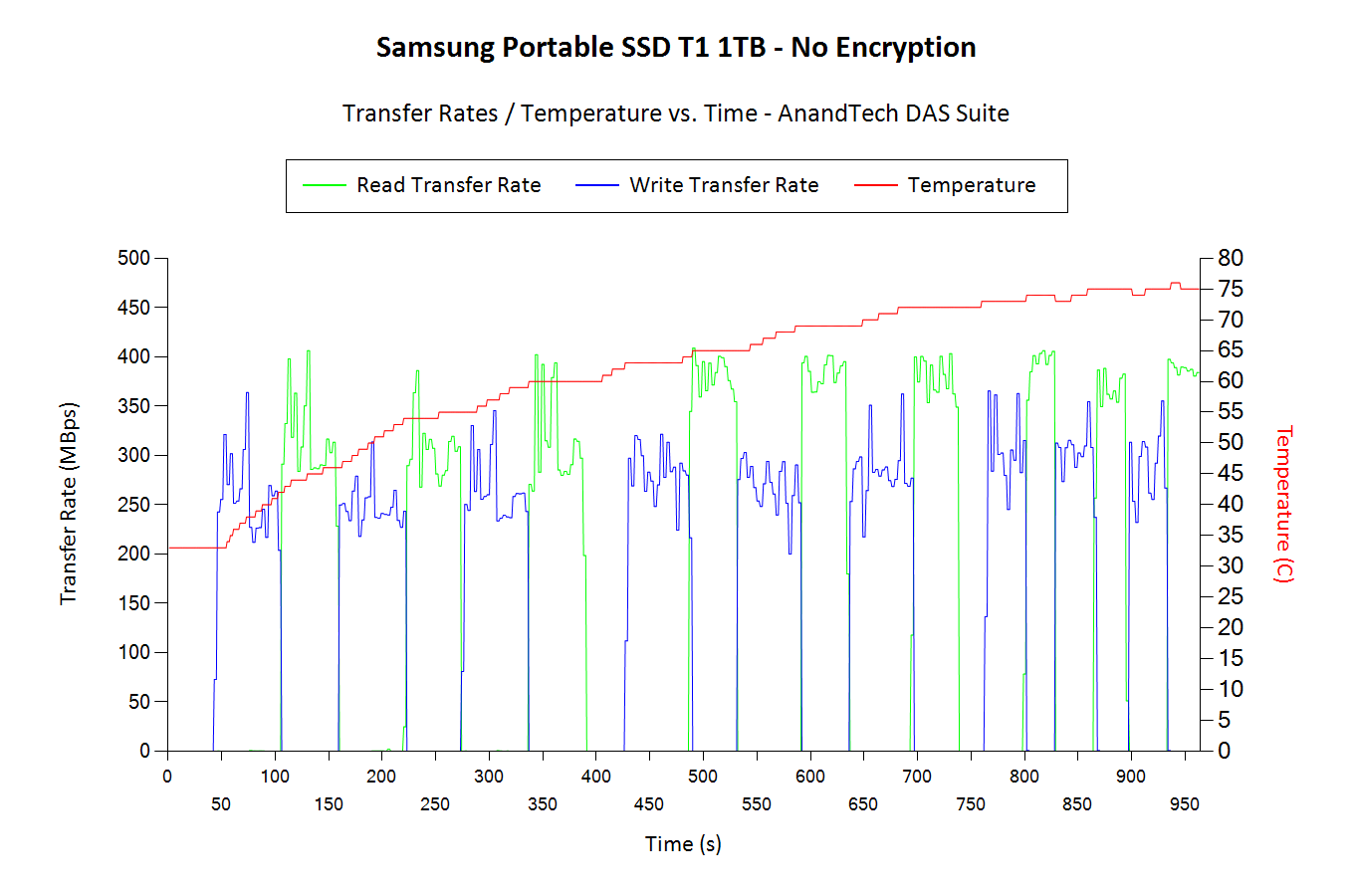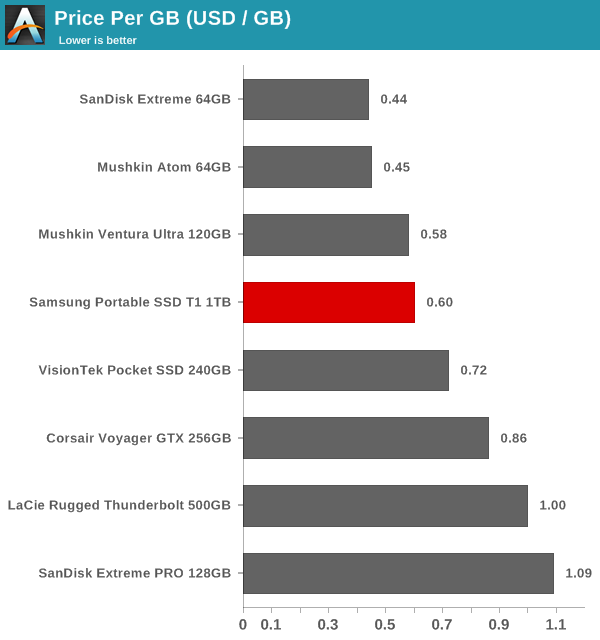Samsung Portable SSD T1 Review
by Ganesh T S on January 20, 2015 10:00 AM ESTPerformance Consistency and Concluding Remarks
Yet another interesting aspect of these types of units is performance consistency. Aspects that may influence this include thermal throttling and firmware caps on access rates to avoid overheating or other similar scenarios. This aspect is an important one, as the last thing that users want to see when copying over, say, 100 GB of data to the external portable SSD, is the transfer rate going to USB 2.0 speeds. In order to identify whether the drive under test suffers from this problem, we instrumented our robocopy DAS benchmark suite to record the flash drive's read and write transfer rates while the robocopy process took place in the background. For supported drives, we also recorded the internal temperature of the drive during the process. The graphs below show the speeds observed during our real-world DAS suite processing. The first three sets of writes and reads correspond to the photos suite. A small gap (for the transfer of the videos suite from the primary drive to the RAM drive) is followed by three sets for the next data set. Another small RAM-drive transfer gap is followed by three sets for the Blu-ray folder.
An important point to note here is that each of the first three blue and green areas correspond to 15.6 GB of writes and reads respectively. For the Samsung Portable SSD T1, we see throttling kick in only after more than 200 GB of data has been transferred continuously (the last two sets of reads in the graph below). The throttling seems to kick in after the drive temperature reaches 75 C. Another interesting aspect is the fact that the temperature rises a bit faster in the case where encryption is enabled.

A Note on TRIM
TRIM support would be really handy for a portable SSD. Usually, we don't see TRIM working over USB. However, the Corsair Voyager GTX with the Phison controller does support TRIM over the USB 3.0 interface. In addition, that drive also supports manual overprovisioning. The T1 has in-built overprovisioning, but manual control over it using the Samsung Magician software would also be nice. Of course, it is also arguable that TRIM and overprovisioning are not really needed for the T1's target market. However, for cases where the T1 is used as a portable OS drive (Windows-To-Go or some sort of portable Linux install), those features could improve user experience.
The internal platform of the T1 (the 850 EVO) does support TRIM. However, Samsung indicated that neither Microsoft nor Apple currently support issuing TRIM commands through the USB interface on their current OS. That said, they are exploring additional methods of forcing TRIM - including manually through the Samsung SSD Magician software. That feature will not be available in time for the launch, though.
Concluding Remarks
Coming to the business end of the review, the Portable SSD T1 brings Samsung to the forefront of external flash drive solution vendors. Keeping the flash fabrication, controller design and fabrication as well as the solution design in-house has enabled it to put out the most reasonably priced (if not, the only) 1TB external flash drive product in the market. The size and weight of the unit are both small enough to actually let the drive hang off the USB 3.0 port as a flash drive. That said, Samsung supplies a very short USB 3.0 cable - it is perfect for notebooks, but not so in the case of desktops with USB ports in the front or rear panels.
The performance of the drive leaves us with no doubt that it would be a great portable OS drive / Windows-to-Go solution, even though Samsung doesn't advertise it for that purpose. Unfortunately, Samsung has not decided to pursue the certification process. As far as non-enterprise consumers go, this is perfectly acceptable - the performance for Windows-to-Go is there without the extra cost associated with obtaining the certification that eventually gets passed on to them.
The only minor points of concern is the inability to recognize and take actions on the drive based on S.M.A.R.T features such as TRIM.

The 1TB 840 EVO mSATA SSD has been in the market for quite some time now. Hence, the size of the Portable SSD T1 didn't come as much of a surprise. From an end-user perspective, the size / capacity of the drive and the price point ($0.60/GB) are very attractive. The Portable SSD T1 makes for a compelling solution where fast transfers of large amounts of data is needed in a secure environment.










68 Comments
View All Comments
haukionkannel - Tuesday, January 20, 2015 - link
It would be very nice to see a comparison of external USB3 storage and different SSD disks to see if there is difference how well SSD will work without trim and is there is difference between controllers etc. It would be also nice to have an article for "dummies" how over provisioning affect in this kind of situation. I am also quite sure that not everyone knows how to change over provisioning with their SSD drives and how does it affect to ssd behavior.As it has been said you can get good quality USB3 enclosure and ssd for much less than there ready made versions. Comparison would be nice!
neillanz - Tuesday, January 20, 2015 - link
What I wonder about the most is if Samsung took care of unexpected power loss problem and if so, then how. The problem I always have while using an SSD with a SATA to USB bridge is that every time I disconnect it, the unexpected power loss count rises. Perhaps know with the UASP, it's possible to send a shutdown command to the drive itself.Laststop311 - Wednesday, January 21, 2015 - link
thats what the little icon in the tray is for. You right click it and select eject usb drive and then a bubble pops up and says it is now safe to disconnect your usb drive. You really didn't know that?neillanz - Wednesday, January 21, 2015 - link
Of course I know about the the Safe Removal option, but so far it never helped when unplugging an SSD. No matter what the unexpected power loss count would grow.digiguy - Tuesday, January 20, 2015 - link
I don't think this drive offers the same comfort of the GTX 256 or Sandisk extreme (I own both) on a very portable device, such as my Surface pro 3 or small ultrabooks. I wouldn't trust moving around with the device and this thing hanging. Also it would be interesting to know how much power this drive drains. According to my tests, the 2 pen drives I mentioned take very little power, while a 2.5" SSD in a USB 3.0 enclosure (I have several of both) takes much more power, much closer to a HDD. I have used a power meter, but even without that I can see that for instance with the Surface I can write between the 2 pen drives in an unpowered hub, and still have a mouse and something else attached, but I generally cannot do it between an external SSD and a pen (sometimes it works but the speed goes down), let alone 2 external SSDs. I have tested several unpowered hub, which themselves take some power, some more than others... Hopefully there will be some testing of the power consumption.Laststop311 - Wednesday, January 21, 2015 - link
You have to normalize the power consumption for the greater performance. Meaning since its faster it finishes the transfer faster and goes back into idle faster. So you need to take into account the amount of power used from transfer start to transfer finish. The other drives may use less power but they are transferring for a longer amount of time and that can easily bring its amount of battery power used close to equal.digiguy - Wednesday, January 21, 2015 - link
Normalize the power consumption for greater performance? I suppose you are comparing an external SSD with the pen drive I mentioned, as SSDs are actually much faster than HHD while consuming less.... As for pen vs SSD, considering the GTX, if we talk about read speed, they are pretty close.... I have several SSDs, among them Crucial MX100, Sandisk Extreme pro and the GTX is close and goes up to the limit of the USB 3.0 bandwith. In terms of write spead, there is a clear gap, but it's well known that write speed and the size of a pen drive don't go well together. Still, compared to "standard" USB 3.0 pen drives, these 2 I mentioned are amazing. The point I was making however was not about battery life, but about the capacity of a small laptop/ultrabook/convertible (as these drives are meant to be used mainly on the go) to power these drives, including moving data directly from one to the other. With the pen drives (even the fastest) you can do that, as their power consumption is a fraction of even that of an external SSD, let alone an HDD. So this is one of the strengths of such drives.sonicmerlin - Tuesday, January 20, 2015 - link
Augh I want someone to release a 20 nm V-NAND SSD that blows away the HDD market's $/GB values. When will this happen?Laststop311 - Wednesday, January 21, 2015 - link
Then you lose the benefits of 40nm which are numerous. Also while you can fit more nand dies per wafer with 20nm the process of making each wafer of dies is more expensive so if the increased amount of dies doesn't offset or better the increased cost of 20nm then it's actually cheaper for them to be at 40nm. You also have to take account of defect rates. If the defect rates of 20nm are a certain percentage higher than 40nm that also makes it hard for the increased amount of dies on 20nm to be enough of a bonus to make it cheaper.AJSB - Wednesday, January 21, 2015 - link
Please NO !20nm will bring back more problems than benefits, if i ever considered a SSD is precisely the 850 EVO because the type of NAND and be 40nm.
What happens now is that Samsung is charging a premium for be the only ones with this type of NAND, AFAIK.
When there will be more players doing it, prices will fall, not to mention that this type of NAND is still in the begin of production...as Samsung increases production, prices will possibly decrease with or without more OEMs doing this type of NAND.